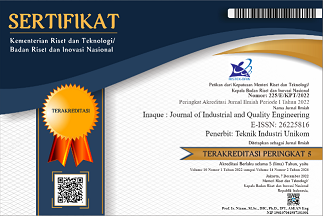USULAN PERBAIKAN KUALITAS PRODUK BENANG DENGAN MENGGUNAKAN METODE KIPLING
DOI:
https://doi.org/10.34010/iqe.v8i1.2784Abstract
This journal presents research on improving product quality in a company. This study aims to identify the factors that cause disability in a product and propose follow-up solutions in order to improve the quality of a product. The method used in the study is the fishbone diagram and the Kipling method (5W + 1H) to improve product quality. The product under study is a yarn product manufactured in the second building of the company. There are 8 types of product defects that cause product quality to decline and are not suitable for sale, which can result in losses to the company, which are not good spools, dirty spools, yarn spools of different diameters, spools of cross yarn, spools of loose yarn, defective cones, incorrect cone types and the weight of the yarn is distorted. From all types of defects, the result shows that the most defects are in the category of bad roll defects of 31%, with the number of defective products of 215 spools of the total defective products of 716 spools. After conducting research, it was concluded that product defects occur due to lack of machine maintenance, mistakes from operators when installing the machine. If the company can reduce the occurrence of defects or damage to the yarn product, it will benefit a lot.
Downloads
Published
Issue
Section
License
Authors who publish this journal agree to the following terms:
The author holds the copyright and grants the right of the first publication journal to enable INAQUE to share the work with acknowledgment of the author's work and early publications in this journal.
Authors may include separate additional contractual arrangements for the non-exclusive distribution of the journal's published version (for example, submit to an institutional repository or publish in a book), with the acknowledgment of its initial publication in this journal
Authors are permitted and encouraged to post their work online before and during the delivery process, as it may lead to productive exchanges, as well as quotations of previously published and longer works








